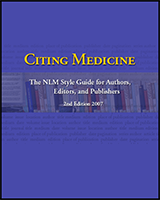Bioengineering
Introduction
This page contains four sections:
Citation Style Guides for Bioengineering
General Style Guides
-
Publication Manual of the American Psychological Association by American Psychological Association Staff
Call number: BF76.7 .P83 2010 (All ASU Libraries except Thunderbird)Publication date: 2009Although written for psychology, this style adapts well for most subjects including engineering. In addition to providing guidance on grammar, the mechanics of writing, and APA style, this manual offers an authoritative reference and citation system.
Style Guides for Medicine
-
 Citing Medicine
by
Karen Patrias; Dan Wendling
Call number: OnlinePublication date: 2007-Provides assistance to authors in compiling lists of references for their publications, to editors in revising such lists, to publishers in setting reference standards for their authors and editors, and to librarians and others in formatting bibliographic citations. Frequently called "Vancouver Style"
Citing Medicine
by
Karen Patrias; Dan Wendling
Call number: OnlinePublication date: 2007-Provides assistance to authors in compiling lists of references for their publications, to editors in revising such lists, to publishers in setting reference standards for their authors and editors, and to librarians and others in formatting bibliographic citations. Frequently called "Vancouver Style" -
AMA Manual of Style by Cheryl Iverson (Editor); Stacy Christiansen (Editor); Annette Flanagin (Editor); JAMA and Archives Journals Staff (Editor)
Call number: R119 .A533 2007 (Downtown, Polytech, Science & West)Publication date: 2007This 10th edition has expanded its electronic guidelines ... Ethical and legal issues receive increased attention, with detailed guidelines on authorship, conflicts of interest, scientific misconduct, intellectual property, and the protection of individuals' rights in scientific research and publication.
Journal Publisher Style Guides and Manuals
Engineering does not have an overall preferred style as other subject areas do, such as medicine and psychology. Instead, instructors/students may use guidelines posted by specific journals within an engineering sub-discipline. Although the terms "Style Guide" or "Style Manual" may be used, many times this information is on the journal's website under a section labeled "Instructions for Authors". These instruction sections usually contain formatting details and how to cite references.
A selection of biomedical journal style guides and author instructions are listed below. If your favorite journal is not listed, use the ASU Library's Journal Lookup List to go to your journal's website and browse the site to find either a "style guide" or "instructions for authors" section.
- Annals of Biomedical Engineering
In the right-hand column, click on "Instructions for Authors" and a box will display in the left-hand column.
- Annual Reviews of Biomedical Engineering: Author Handbook (pdf)
- Biomaterials: Author Information Pack (pdf)
- Biomedical Materials: Author Guidelines
Used by most of the Institute of Physics (IOP) journals.
- IEEE Style Manual (pdf)
Used by most of the "IEEE Transactions" journals.
- Journal of Neuroscience: Organization of the Manuscript: References
Index
Alerts
Articles
Ask a Librarian
ASU Publications
Background Information
Books
Business Information
Career Information
Citation Management
Citing Your Sources
Current Awareness Searching
Designing Posters
Document Delivery Services
Encyclopedias
Facts
Find a Citation
Find a Known Item
Formulas
Getting Started
Gray Literature
Help
Home Page
Industry Information
Industry Standards
Intellectual Property
Interlibrary Loan Services
Jobs
Journal Articles
Keeping Current
Library News
Literature Review
Materials
Medical Devices
New Items in the Libraries
Overviews
Patents
Poster Design
Properties of Materials
Quick Facts
Recent ASU Publications
Research a Topic
RSS Feeds
Standards
Statistics
Saved Searches
Summaries
Trade Information
Technical Reports
Topic Searching
Writing a Report/Paper